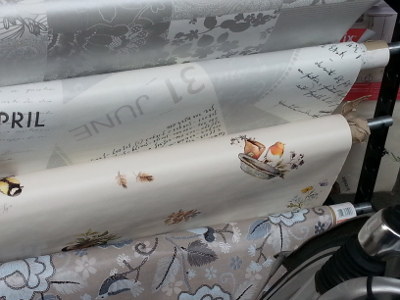We know and love Holland (or “the Netherlands” as the locals would have you call it) for its tulips, clogs, windmills and bicycles. And for being flat.
In an earlier post I asked What is it with Holland and time travel? Indeed, I have even witnessed time travel here, to a certain extent. Perhaps!
Holland now presents to us a new view on time, or at least our marking of its passage. A couple of days ago I saw this rack of table cloths outside a shop called “Marskramer” (“Peddlar”). It’s basically a bric-a-brac kind of a shop which sells…well. Table clothes for one thing.

Much as I hate this mnemonic, it does come to mind…
“Thirty days hath September, April, June…”
Well maybe we can forgive our Dutch friends for their strange idea of the English calendar (if not for their hideous taste in table cloths). The author of the novel The Go Between, L. P. Hartley, noted the following:
“The past is a foreign country: they do things differently there.” – L. P. Hartley.
I think the same applies for Holland; Holland is a foreign country, and they do things very differently here.
Take counting. You know, like you might count the days in the month, for example 😉 Cavemen counted with stones, my 2 year old can manage up to 8 (she must be a computer!), so counting can’t be that tough can it?
Let’s take 123
English: “One hundred and twenty three.”
Hundreds, tens, units. Simple and logical. Easy as, literally, 1, 2, 3.
Dutch: “One hundred, three and twenty.”
Hundreds, units then back in the middle to tens. It’s all over the place. Easy as…1, 3, 2?
Then take 123,456
English: “one hundred and twenty three thousand, four hundred and fifty six.”
Dutch: “one hundred, three and twenty thousand, four hundred six and fifty.”
1, 3, 2, 4, 6, 5
Confused?!!
(Oh yes. And there’s the use of a comma in place of a decimal point!)
And telling the time. This was possible as early as 1500 BC with sundials (source: Wikipedia.) So it shouldn’t be complicated, right?
Ha! In Dutch, “Half two” means “half one”. It’s an optimistic outlook where the Dutch look forward ‘two’ the hour rather than back to the ‘one’ that’s passed. (See what I did there?! 😉 )
It’s really tricky to remember 10 minutes later when it’s embedded in a string:
English: “twenty to two”
Dutch: “ten past half two”
Are we going backwards or forwards here? Is the big hand going 10 minutes past the 6, or forward to the 2? Who knows?
I think the Dutch are surely they are the true masters of time – they’ve even come up with an extra day in June!
Paul
If you enjoyed this post, you might like to visit or like time2timetravel on Facebook

